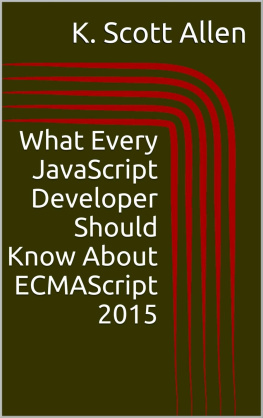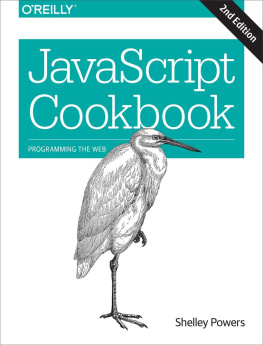Adam D. Scott - JavaScript Cookbook, 3rd Edition
Here you can read online Adam D. Scott - JavaScript Cookbook, 3rd Edition full text of the book (entire story) in english for free. Download pdf and epub, get meaning, cover and reviews about this ebook. year: 2021, publisher: OReilly Media, Inc., genre: Computer. Description of the work, (preface) as well as reviews are available. Best literature library LitArk.com created for fans of good reading and offers a wide selection of genres:
Romance novel
Science fiction
Adventure
Detective
Science
History
Home and family
Prose
Art
Politics
Computer
Non-fiction
Religion
Business
Children
Humor
Choose a favorite category and find really read worthwhile books. Enjoy immersion in the world of imagination, feel the emotions of the characters or learn something new for yourself, make an fascinating discovery.
- Book:JavaScript Cookbook, 3rd Edition
- Author:
- Publisher:OReilly Media, Inc.
- Genre:
- Year:2021
- Rating:4 / 5
- Favourites:Add to favourites
- Your mark:
- 80
- 1
- 2
- 3
- 4
- 5
JavaScript Cookbook, 3rd Edition: summary, description and annotation
We offer to read an annotation, description, summary or preface (depends on what the author of the book "JavaScript Cookbook, 3rd Edition" wrote himself). If you haven't found the necessary information about the book — write in the comments, we will try to find it.
JavaScript Cookbook, 3rd Edition — read online for free the complete book (whole text) full work
Below is the text of the book, divided by pages. System saving the place of the last page read, allows you to conveniently read the book "JavaScript Cookbook, 3rd Edition" online for free, without having to search again every time where you left off. Put a bookmark, and you can go to the page where you finished reading at any time.
Font size:
Interval:
Bookmark:

by Adam D. Scott , Matthew MacDonald , and Shelley Powers
Copyright 2021 Adam D. Scott and Matthew MacDonald. All rights reserved.
Printed in the United States of America.
Published by OReilly Media, Inc. , 1005 Gravenstein Highway North, Sebastopol, CA 95472.
OReilly books may be purchased for educational, business, or sales promotional use. Online editions are also available for most titles (http://oreilly.com). For more information, contact our corporate/institutional sales department: 800-998-9938 or corporate@oreilly.com .
- Acquisitions Editor: Jennifer Pollock
- Development Editor: Angela Rufino
- Production Editor: Katherine Tozer
- Copyeditor: Sonia Saruba
- Proofreader: James Fraleigh
- Indexer: Potomac Indexing, LLC
- Interior Designer: David Futato
- Cover Designer: Karen Montgomery
- Illustrator: Kate Dullea
- July 2021: Third Edition
- 2021-07-16: First Release
See http://oreilly.com/catalog/errata.csp?isbn=9781492055754 for release details.
The OReilly logo is a registered trademark of OReilly Media, Inc. JavaScript Cookbook, the cover image, and related trade dress are trademarks of OReilly Media, Inc.
The views expressed in this work are those of the authors, and do not represent the publishers views. While the publisher and the authors have used good faith efforts to ensure that the information and instructions contained in this work are accurate, the publisher and the authors disclaim all responsibility for errors or omissions, including without limitation responsibility for damages resulting from the use of or reliance on this work. Use of the information and instructions contained in this work is at your own risk. If any code samples or other technology this work contains or describes is subject to open source licenses or the intellectual property rights of others, it is your responsibility to ensure that your use thereof complies with such licenses and/or rights.
978-1-492-05575-4
[LSI]
As I sat down to work on the latest edition of JavaScript Cookbook, I considered the cookbook metaphor carefully. What makes a great food cookbook? Browsing the cookbooks on a shelf in my dining room, I noted that my favorites not only have delicious recipes, but they are also full of opinionated hard-earned advice. A cookbook rarely seeks to teach you every recipe for beef bourguignon; rather it teaches you the technique and recipe that the author has found works best for them, typically with a bit of advice thrown in for good measure. Its with this concept in mind that we put together this collection of JavaScript recipes. The advice in this book comes from three seasoned pros, but it is ultimately the culmination of our unique experiences. Any other group of developers would have likely produced a similar, but different book.
JavaScript has developed into an amazing and powerful multipurpose programming language. With this collection in hand you will be able to solve all sorts of problems that you encounter and may even begin to develop recipes of your own.
To encompass the many subjects and topics reflective of JavaScript in use today, we had to start with one premise: this is not a book for someone brand new to programming. There are so many good books and tutorials for those looking to learn to program with JavaScript that we felt comfortable targeting the practicing developer, someone looking to solve specific problems and challenges with JavaScript.
If youve been playing around with JavaScript for several months, maybe tried your hand with a little Node or web development, you should be comfortable with the book material. Additionally, if youre a developer who primarily works in another programming language, but find yourself needing to use JavaScript from time to time, this should be a helpful guide. Finally, if youre a working JavaScript developer who sometimes gets stuck on some of the idiosyncrasies of the language, this should act as a useful resource.
There are two types of readers of this book. The first is someone who reads it cover to cover, picking up tidbits of applicable knowledge along the way. The second is someone who dips their toes in as needed, seeking out the solution to a specific challenge or category of problem that they face. We attempted to organize the book in such a way that it would be useful to both types of readers, organizing it into three sections:
, covers recipes for JavaScript as a programming language.
, covers JavaScript in its natural habitat: the browser.
, looks at JavaScript specifically through the lens of Node.js.
Each chapter of the book is broken down into several individual recipes. A recipe is composed of several parts:
ProblemThis defines a common development scenario where JavaScript may be used.
SolutionA solution to the problem, with a code sample and minimal description.
DiscussionAn in-depth discussion of the code sample and techniques.
Additionally, a recipe may contain recommendations for further reading in a See Also section, or additional techniques in an Extra section.
The following typographical conventions are used in this book:
ItalicIndicates new terms, URLs, email addresses, filenames, and file extensions.BoldIndicates UI items such as menu items and buttons to be selected or clicked.Constant widthIndicates computer code in a broad sense, including commands, arrays, elements, statements, options, switches, variables, attributes, keys, functions, types, classes, namespaces, methods, modules, properties, parameters, values, objects, events, event handlers, XML tags, HTML tags, macros, the contents of files, and the output from commands.Constant width boldShows commands or other text that should be typed literally by the user.Constant width italichows text that should be replaced with user-supplied values or by values determined by context. This element signifies a general note.
This element signifies a tip or suggestion.
This element indicates a warning or caution.
Websites and pages are mentioned in this book to help you locate online information that might be useful. Normally both the address (URL) and the name (or title, or appropriate heading) of a page are mentioned. Some addresses are relatively complicated. You may locate such pages more easily using your favorite search engine to search for a page by its name. This may also help if the page cannot be found by its address; the URL may have changed, but the name may still work.
Supplemental material (code examples, exercises, etc.) is available for download at https://github.com/javascripteverywhere/cookbook.
This book is here to help you get your job done. In general, if example code is offered with this book, you may use it in your programs and documentation. You do not need to contact us for permission unless youre reproducing a significant portion of the code. For example, writing a program that uses several chunks of code from this book does not require permission. Selling or distributing examples from OReilly books does require permission. Answering a question by citing this book and quoting example code does not require permission. Incorporating a significant amount of example code from this book into your products documentation does require permission .
Font size:
Interval:
Bookmark:
Similar books «JavaScript Cookbook, 3rd Edition»
Look at similar books to JavaScript Cookbook, 3rd Edition. We have selected literature similar in name and meaning in the hope of providing readers with more options to find new, interesting, not yet read works.
Discussion, reviews of the book JavaScript Cookbook, 3rd Edition and just readers' own opinions. Leave your comments, write what you think about the work, its meaning or the main characters. Specify what exactly you liked and what you didn't like, and why you think so.

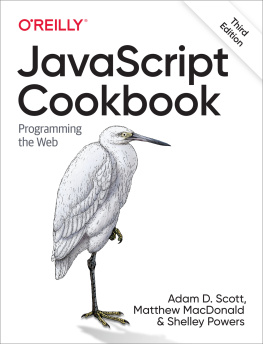

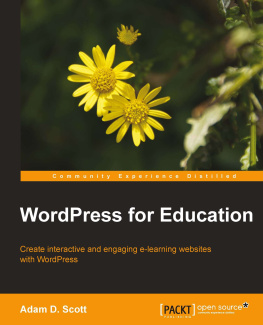
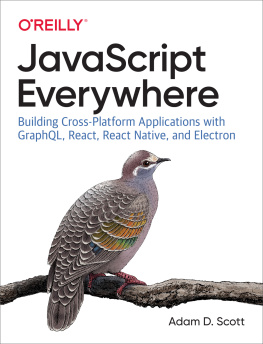
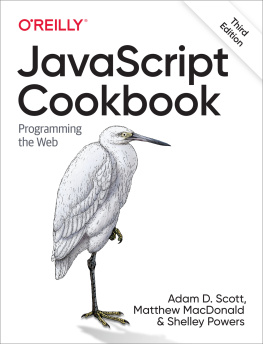
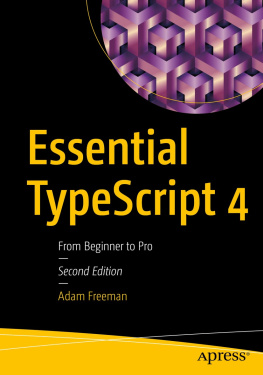
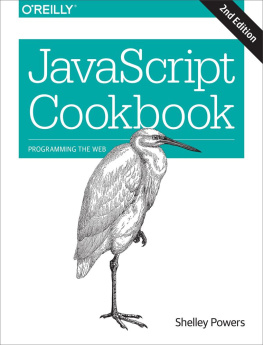
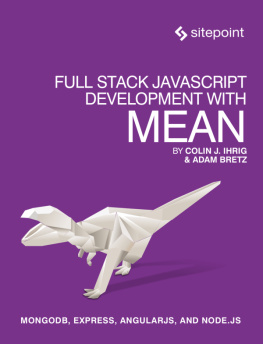
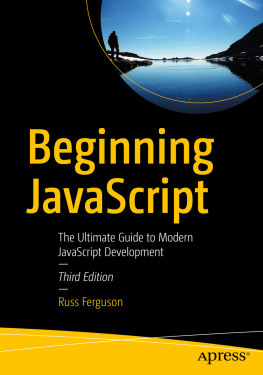
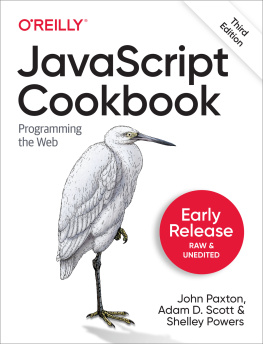

![Nicholas C. Zakas [Nicholas C. Zakas] - Professional: JavaScript® for Web Developers, Third Edition](/uploads/posts/book/121419/thumbs/nicholas-c-zakas-nicholas-c-zakas.jpg)
